City contours Hamburg
Groovy, individualist and friendly is what Hamburg is all about
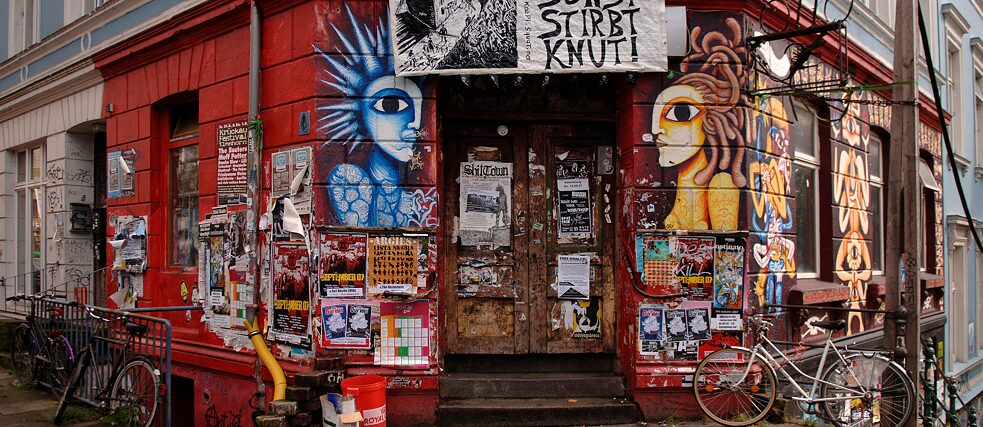
The colourful, bohemian Sankt Pauli district.
|
Photo (detail): © picture alliance/Helmut Meyer zur Capellen/imageBROKER
Rumour has it that the residents of this former Hanseatic League city between the Alster and the Elbe rivers listen to sea shanties, eat “Labskaus”, and are fairly taciturn. And there’s some truth to that, of course. But people from Hamburg are also musical polyglots, march to the beat of their very own drums, and have an unvarnished view of their history. Author Ingo Scheel takes us on a tour of the “Tor zur Welt” (gateway to the world).
By Ingo Scheel
Hate has turned to love: the Elbphilharmonie
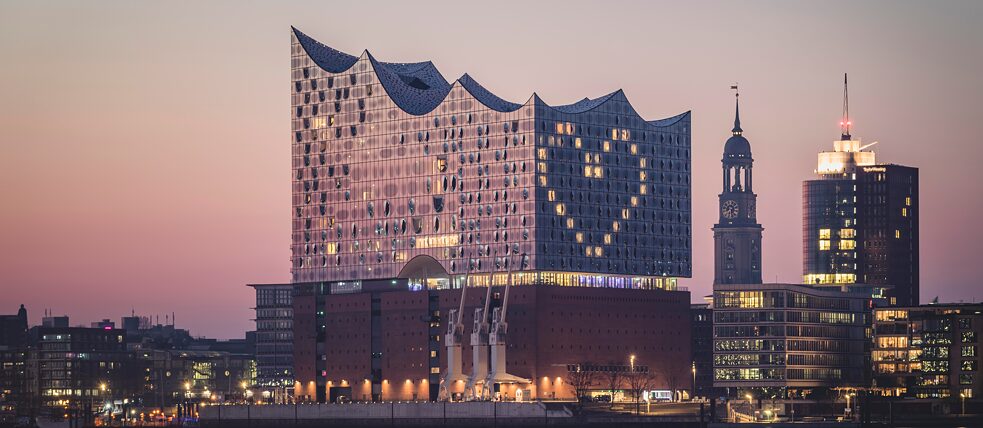 The anger and frustration at the endless Elbphilharmonie project has turn into pride and pleasure.
| Photo (detail): © picture alliance/Westend61/Kerstin Bittner
The Elbphilharmonie was a bone of contention for years. The building, critics said, was too massive, construction too expensive, and the project too big. Once complete though, the Elphi, as locals dubbed it, began writing its own history and residents warmed to the opulent concert hall the moment it opened its doors. Along with classical music highlights, the venue also welcomes rock, pop and indie artists to its stages. Performers have included folk singer-songwriter Anna Ternheim, James Blunt and his lonely Corona concert, and Burt Bacharach with his lifework gala. In a wonderfully ironic Elphi twist, just as band Einstürzende Neubauten, whose name roughly translates as “collapsing new buildings”, began playing in the large concert hall, the crooked, winding and supposedly longest escalator in Western Europe decided to give up the ghost.
The anger and frustration at the endless Elbphilharmonie project has turn into pride and pleasure.
| Photo (detail): © picture alliance/Westend61/Kerstin Bittner
The Elbphilharmonie was a bone of contention for years. The building, critics said, was too massive, construction too expensive, and the project too big. Once complete though, the Elphi, as locals dubbed it, began writing its own history and residents warmed to the opulent concert hall the moment it opened its doors. Along with classical music highlights, the venue also welcomes rock, pop and indie artists to its stages. Performers have included folk singer-songwriter Anna Ternheim, James Blunt and his lonely Corona concert, and Burt Bacharach with his lifework gala. In a wonderfully ironic Elphi twist, just as band Einstürzende Neubauten, whose name roughly translates as “collapsing new buildings”, began playing in the large concert hall, the crooked, winding and supposedly longest escalator in Western Europe decided to give up the ghost.
When night falls in wonderland
 See Venice in breath-taking detail on a visit to Minatur Wunderland.
| Photo (detail): © picture alliance/dpa/Georg Wendt
Miniatur Wunderland had fans back when it was just a thought experiment. Former night club and music label owner and Wunderland founder Frederik Braun first floated the idea of building the world’s largest model railroad in Hamburg’s historical warehouse district, the Speicherstadt, back in the year 2000 after a visit to model train store in Zurich. He then posted an online survey where over 3,000 people rated which of 45 suggested sights, some fictitious, they would most like to visit on a trip to Hamburg. One of these imaginary places, Miniatur Wunderland, made it to third place among male prospective tourists. Frederik and his brother Gerrit took this as a sign that their idea had legs. Some two decades later, around 1.5 million visitors large and small come to Wunderland every year to marvel at the roughly quarter of a million figurines, buildings, trains and planes that line the 16 kilometres of model train tracks. In addition to admiring the made-up city of Knuffigen, and many tiny reproductions of actual metropolises and continents, visitors can also watch night falls then day dawn every 15 minutes, almost like in the real world.
See Venice in breath-taking detail on a visit to Minatur Wunderland.
| Photo (detail): © picture alliance/dpa/Georg Wendt
Miniatur Wunderland had fans back when it was just a thought experiment. Former night club and music label owner and Wunderland founder Frederik Braun first floated the idea of building the world’s largest model railroad in Hamburg’s historical warehouse district, the Speicherstadt, back in the year 2000 after a visit to model train store in Zurich. He then posted an online survey where over 3,000 people rated which of 45 suggested sights, some fictitious, they would most like to visit on a trip to Hamburg. One of these imaginary places, Miniatur Wunderland, made it to third place among male prospective tourists. Frederik and his brother Gerrit took this as a sign that their idea had legs. Some two decades later, around 1.5 million visitors large and small come to Wunderland every year to marvel at the roughly quarter of a million figurines, buildings, trains and planes that line the 16 kilometres of model train tracks. In addition to admiring the made-up city of Knuffigen, and many tiny reproductions of actual metropolises and continents, visitors can also watch night falls then day dawn every 15 minutes, almost like in the real world.
Pickets, not fences, make good neighbours
 Even Lily Allen has taken the stage in Knust on Lattenplatz
| Photo (detail): © picture alliance/Jazzarchiv/Rainer Merkel
Anyone looking to enjoy some of Hamburg’s nightlife flair would do well to start at Lattenplatz (roughly translates as Picket Square). Somehow a homebrewed Astra beer tastes best here in the heart of Hamburg’s internationally famed Sankt Pauli district next-door to the Flohschanze named for the flea market that takes play every Saturday no matter the weather. Hamburg’s hip quarter, the Sternschanze, Millerntor Stadium and the Karolinenviertel known for all its cafes and little boutiques intersect at Lattenplatz. It is also the epicentre of the Hamburg sound where local heroes like Bernd Begemann and Die Liga der gewöhnlichen Gentlemen (the league of conventional gentlemen) play in live club Knust, joining the likes of international greats like Laura Cox and Billy Bragg. Across the road, Smallville Records and Hanseplatte offer vinyl ranging from Julius Steinhoff and Alice Merton to Rocko Schamoni and Boy. And if you’ve got space in your bag for another record or two, pop over to Groove City, Ruff Trade or Zardoz Imperium to hear recommendations for the freshest sounds, newest insider tips, or most exotic record ever.
Even Lily Allen has taken the stage in Knust on Lattenplatz
| Photo (detail): © picture alliance/Jazzarchiv/Rainer Merkel
Anyone looking to enjoy some of Hamburg’s nightlife flair would do well to start at Lattenplatz (roughly translates as Picket Square). Somehow a homebrewed Astra beer tastes best here in the heart of Hamburg’s internationally famed Sankt Pauli district next-door to the Flohschanze named for the flea market that takes play every Saturday no matter the weather. Hamburg’s hip quarter, the Sternschanze, Millerntor Stadium and the Karolinenviertel known for all its cafes and little boutiques intersect at Lattenplatz. It is also the epicentre of the Hamburg sound where local heroes like Bernd Begemann and Die Liga der gewöhnlichen Gentlemen (the league of conventional gentlemen) play in live club Knust, joining the likes of international greats like Laura Cox and Billy Bragg. Across the road, Smallville Records and Hanseplatte offer vinyl ranging from Julius Steinhoff and Alice Merton to Rocko Schamoni and Boy. And if you’ve got space in your bag for another record or two, pop over to Groove City, Ruff Trade or Zardoz Imperium to hear recommendations for the freshest sounds, newest insider tips, or most exotic record ever.
A dragon who is fond of strawberries
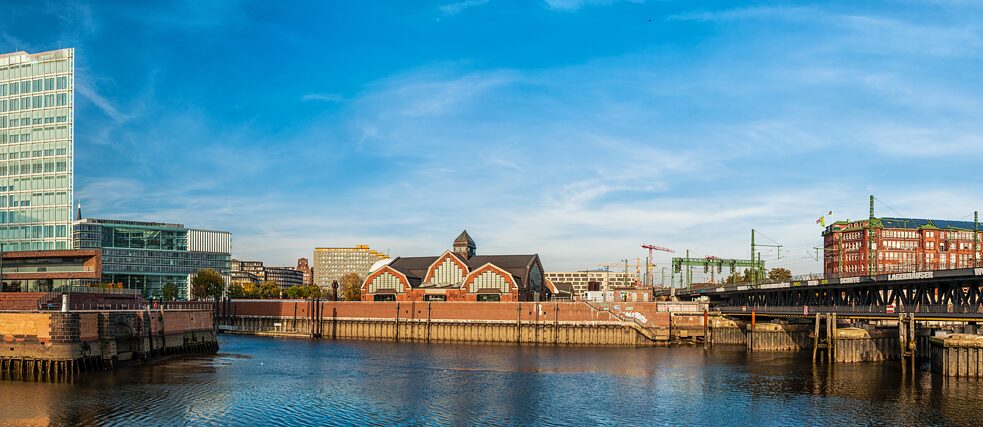 In addition to contemporary art and photography, Hamburg’s Deichtorhallen also features culinary delights.
| Photo (detail): © Adobe
When it comes to food, the Hanseatic City of Hamburg is particularly known for serving up perfect fish in a variety of forms from the humble fish roll to-go to caviar at a candlelight dinner. The riverside city has so much more to offer as well. International restaurants bring West African fufu, Tibetan momos and “real Peking duck” to the table. A host of gourmet restaurants includes around a dozen with a Michelin star serving up fine delicacies in the most elegant ambience. The erdbeerfressende Drache (strawberry-eating dragon), for example, is a fine dining establishment founded in Hamburg’s Deichtorhallen museum in 2019. Its motto could be “artistically prepared food in an artistic ambiance”. In the historic halls of this exhibition space for contemporary art, diners can enjoy unusual culinary delights made from unexpected combinations of ingredients – such as “mushrooms & melon” or “sardine & hay”. Small portions are served at the counter so every guest can try a number of dishes. It is a bit like tapas got an haute cuisine upgrade from Hamburg’s well-known top chef Thorsten Gillert, who owned a restaurant in the Schanze quarter before working on board the MS Europa cruise ship.
In addition to contemporary art and photography, Hamburg’s Deichtorhallen also features culinary delights.
| Photo (detail): © Adobe
When it comes to food, the Hanseatic City of Hamburg is particularly known for serving up perfect fish in a variety of forms from the humble fish roll to-go to caviar at a candlelight dinner. The riverside city has so much more to offer as well. International restaurants bring West African fufu, Tibetan momos and “real Peking duck” to the table. A host of gourmet restaurants includes around a dozen with a Michelin star serving up fine delicacies in the most elegant ambience. The erdbeerfressende Drache (strawberry-eating dragon), for example, is a fine dining establishment founded in Hamburg’s Deichtorhallen museum in 2019. Its motto could be “artistically prepared food in an artistic ambiance”. In the historic halls of this exhibition space for contemporary art, diners can enjoy unusual culinary delights made from unexpected combinations of ingredients – such as “mushrooms & melon” or “sardine & hay”. Small portions are served at the counter so every guest can try a number of dishes. It is a bit like tapas got an haute cuisine upgrade from Hamburg’s well-known top chef Thorsten Gillert, who owned a restaurant in the Schanze quarter before working on board the MS Europa cruise ship.
Nippon so near
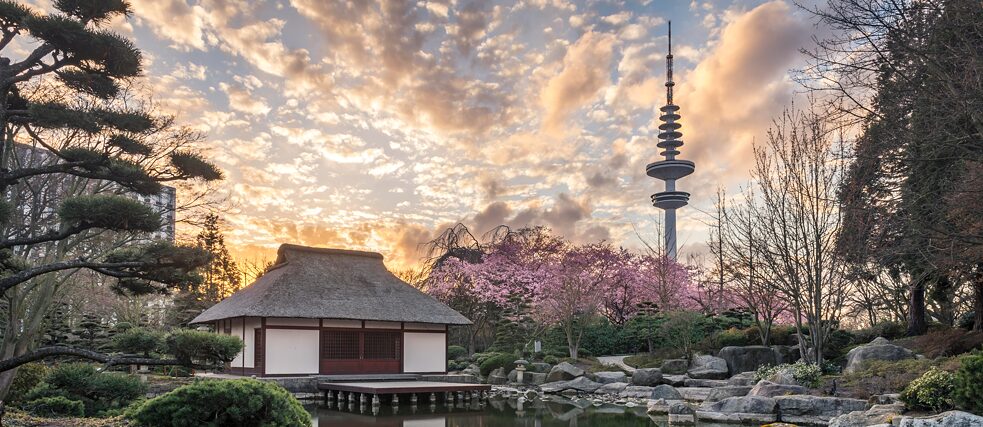 Asian flair in the Japanese Garden.
| Photo (detail): © picture alliance/Westend61/Kerstin Bittner
While “Planten un Blomen” may a bit like a typical North German cosy allotment garden community, it is actually an impressive 50 hectares of parkland with small waterways, wide meadows and colourful flowerbeds. Winter is a good time to discover the ice rink with its nostalgic flair and try your hand at mini golf just around the corner in summer. If you are looking to take the pace down a notch or two, the Japanese Garden is ideal for relaxing. In the late 1980s, landscape architect Yoshikuni Araki designed it in keeping with East Asian aesthetics and philosophy, and tea ceremonies and numerous cultural events have been held here ever since. Visitors say they are overcome by a sense of calm the moment they enter the garden with all its formal austerity, beds of plants and rocks, and the pavilion with its clean lines.
Asian flair in the Japanese Garden.
| Photo (detail): © picture alliance/Westend61/Kerstin Bittner
While “Planten un Blomen” may a bit like a typical North German cosy allotment garden community, it is actually an impressive 50 hectares of parkland with small waterways, wide meadows and colourful flowerbeds. Winter is a good time to discover the ice rink with its nostalgic flair and try your hand at mini golf just around the corner in summer. If you are looking to take the pace down a notch or two, the Japanese Garden is ideal for relaxing. In the late 1980s, landscape architect Yoshikuni Araki designed it in keeping with East Asian aesthetics and philosophy, and tea ceremonies and numerous cultural events have been held here ever since. Visitors say they are overcome by a sense of calm the moment they enter the garden with all its formal austerity, beds of plants and rocks, and the pavilion with its clean lines.Space for the creative arts
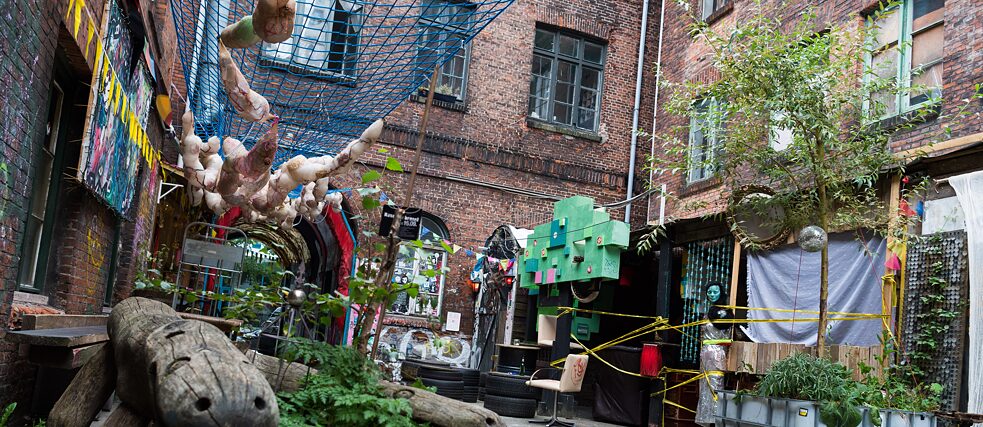 The Schierspassage in the Gängeviertel.
| Photo (detail): © picture alliance/dpa/Christophe Gateau
Fighting for housing Hamburg is a long and often painful tradition. In addition to the notorious Hafenstraße where the battle between squatters and police simmered for a while before coming to a head in 1987, the Gängeviertel (lit. alleyway quarter) is another place residents pursue alternative lifestyles today. With a history going back to the 18th century, this close cluster of buildings once housed the Hamburg’s workers and stretched from the port to the city centre. Torn down, built back up, and bombed to rubble, in the noughties the remaining buildings between Bäckerbreitergang, Caffamacherreihe, Valentinskamp und Speckstraße (lit. wide baker’s alleyway, coffee maker’s row, Valentine’s field and bacon street respectively) came under threat. The historical buildings had been sold to an investor and most were supposedly slated for destruction. The Komm in die Gänge initiative (lit. both “come to the alleyways” and “get it in gear”) and the Genossenschaft Gängeviertel eG succeeded in saving them from the wrecking ball. Today the quarter hosts social projects, concerts, art workshops and evening discussions. The new, old Gängeviertel celebrated its 10th birthday in summer 2019.
The Schierspassage in the Gängeviertel.
| Photo (detail): © picture alliance/dpa/Christophe Gateau
Fighting for housing Hamburg is a long and often painful tradition. In addition to the notorious Hafenstraße where the battle between squatters and police simmered for a while before coming to a head in 1987, the Gängeviertel (lit. alleyway quarter) is another place residents pursue alternative lifestyles today. With a history going back to the 18th century, this close cluster of buildings once housed the Hamburg’s workers and stretched from the port to the city centre. Torn down, built back up, and bombed to rubble, in the noughties the remaining buildings between Bäckerbreitergang, Caffamacherreihe, Valentinskamp und Speckstraße (lit. wide baker’s alleyway, coffee maker’s row, Valentine’s field and bacon street respectively) came under threat. The historical buildings had been sold to an investor and most were supposedly slated for destruction. The Komm in die Gänge initiative (lit. both “come to the alleyways” and “get it in gear”) and the Genossenschaft Gängeviertel eG succeeded in saving them from the wrecking ball. Today the quarter hosts social projects, concerts, art workshops and evening discussions. The new, old Gängeviertel celebrated its 10th birthday in summer 2019.Literature to go
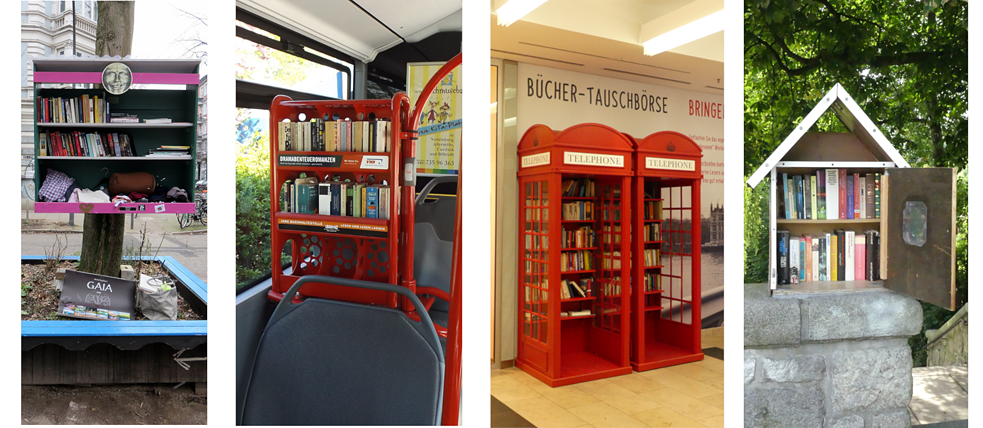 There are other little libraries in other places, but they are more imaginative in Hamburg
| Photo (detail): © Wikipedia/Vitavia CC BY-SA 4.0 and Wikipedia/Finte CC BY 3.0
The idea is as simple as it is ingenious: place a cupboard on any street corner and fill it with books for the general public to take whenever they want. Sure, there are other little free libraries in other places, but Hamburg has added some very imaginative touches. What started with a handful of cupboards around ten years ago has grown to about 160 little free libraries throughout the Hanseatic city today, and the number is rising. Proponents of this form of book exchange didn’t stop at cupboards either, turning birdhouses and discarded telephone booths, even some English red telephone boxes, into book havens, some with atmospheric lighting and decorative shelves. A variety of book lovers keep them filled, including Greenpeace, smaller skilled-trade businesses and district initiatives as well as libraries and project groups. By now the concept has hit the road and many urban public transport busses sport a well-stocked book shelf directly behind the driver’s seat.
There are other little libraries in other places, but they are more imaginative in Hamburg
| Photo (detail): © Wikipedia/Vitavia CC BY-SA 4.0 and Wikipedia/Finte CC BY 3.0
The idea is as simple as it is ingenious: place a cupboard on any street corner and fill it with books for the general public to take whenever they want. Sure, there are other little free libraries in other places, but Hamburg has added some very imaginative touches. What started with a handful of cupboards around ten years ago has grown to about 160 little free libraries throughout the Hanseatic city today, and the number is rising. Proponents of this form of book exchange didn’t stop at cupboards either, turning birdhouses and discarded telephone booths, even some English red telephone boxes, into book havens, some with atmospheric lighting and decorative shelves. A variety of book lovers keep them filled, including Greenpeace, smaller skilled-trade businesses and district initiatives as well as libraries and project groups. By now the concept has hit the road and many urban public transport busses sport a well-stocked book shelf directly behind the driver’s seat. The eye of St. Pauli
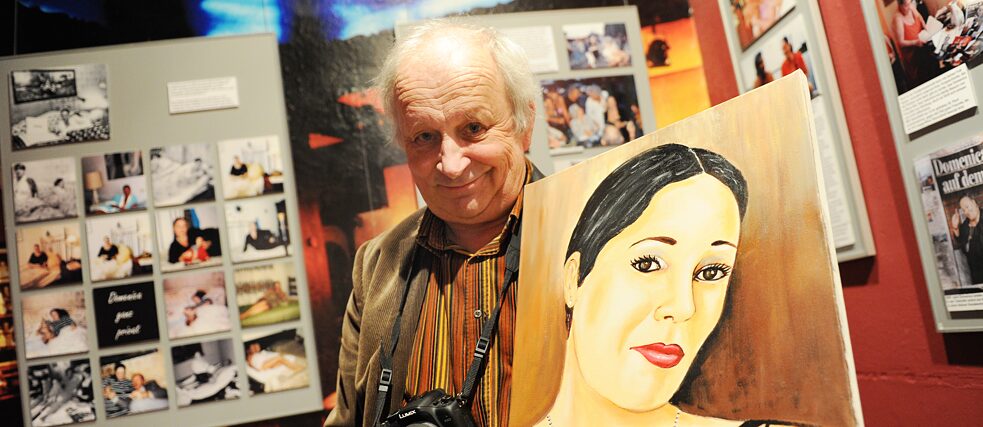 Günter Zint in his St. Pauli Museum
| Photo (detail): © picture alliance /Angelika Warmuth/dpa
Few contemporary witnesses have documented Hamburg’s history as thoroughly and well as photographer Günter Zint, who opened the St. Pauli Museum to feature his collection of pictures, artefacts and precious objects. Born in Fulda in 1941, he moved to Hamburg in the 1960s following military service and training with the dpa news agency. Zint takes photos wherever he goes. He photographed the bands that played the Star Club and documented the pub scene and luminaries of the St. Pauli neighbourhood. He has trained his lens on celebrities like the Beatles, Jimmy Hendricks and Hamburg prostitute and St. Pauli icon Domenica. Zint went on to chronicle the eventful years of the anti-nuclear movement, accompanied Robert Kennedy on the campaign trail in the USA, and was drawn into street battles in Londonderry. Back in Hamburg, he worked as a film photographer, cover artist and author. Recently the St. Pauli Museum found itself in dire financial straits, but it has now been saved and is housed at lower end of the Reeperbahn at Nobistor where a gate to the city once stood.
Günter Zint in his St. Pauli Museum
| Photo (detail): © picture alliance /Angelika Warmuth/dpa
Few contemporary witnesses have documented Hamburg’s history as thoroughly and well as photographer Günter Zint, who opened the St. Pauli Museum to feature his collection of pictures, artefacts and precious objects. Born in Fulda in 1941, he moved to Hamburg in the 1960s following military service and training with the dpa news agency. Zint takes photos wherever he goes. He photographed the bands that played the Star Club and documented the pub scene and luminaries of the St. Pauli neighbourhood. He has trained his lens on celebrities like the Beatles, Jimmy Hendricks and Hamburg prostitute and St. Pauli icon Domenica. Zint went on to chronicle the eventful years of the anti-nuclear movement, accompanied Robert Kennedy on the campaign trail in the USA, and was drawn into street battles in Londonderry. Back in Hamburg, he worked as a film photographer, cover artist and author. Recently the St. Pauli Museum found itself in dire financial straits, but it has now been saved and is housed at lower end of the Reeperbahn at Nobistor where a gate to the city once stood.
Hells Bells or for whom the bell finally tolls
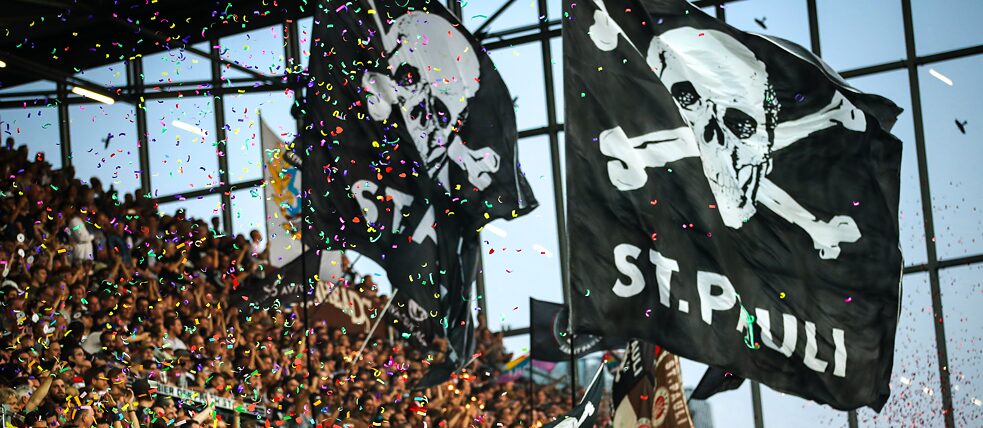 FC St Pauli is the coolest club in the Bundesliga with a cult following that extends beyond the borders of Hamburg.
| Photo (detail): © picture alliance/Christian Charisius/dpa
Hamburg prides itself on having not one but two Bundesliga soccer clubs that have made sporting history. There is the Hamburger SV, which from its founding lasted an incredible 55 years in the first division. The club was so proud of this accomplishment that it installed a clock in the stadium to count the minutes of the continuing record. But the bell finally tolled for the HSV in 2018, when the club slipped into the second division after losing steam for years. This is also where Hamburg’s second major Bundesliga club has played for around 10 years. FC St. Pauli is far and away the chilliest cult club of them all– which even Dortmund and Cologne fans are forced to admit. In a league of its own when it comes to pure coolness, its players run out onto the pitch to AC/DC’s Hells Bells and the “Woo hoo!” from Blur’s Song 2 sounds out through the stadium with every goal. So for the moment at least, Hamburg’s football fans can look forward to a local head-to-head.
FC St Pauli is the coolest club in the Bundesliga with a cult following that extends beyond the borders of Hamburg.
| Photo (detail): © picture alliance/Christian Charisius/dpa
Hamburg prides itself on having not one but two Bundesliga soccer clubs that have made sporting history. There is the Hamburger SV, which from its founding lasted an incredible 55 years in the first division. The club was so proud of this accomplishment that it installed a clock in the stadium to count the minutes of the continuing record. But the bell finally tolled for the HSV in 2018, when the club slipped into the second division after losing steam for years. This is also where Hamburg’s second major Bundesliga club has played for around 10 years. FC St. Pauli is far and away the chilliest cult club of them all– which even Dortmund and Cologne fans are forced to admit. In a league of its own when it comes to pure coolness, its players run out onto the pitch to AC/DC’s Hells Bells and the “Woo hoo!” from Blur’s Song 2 sounds out through the stadium with every goal. So for the moment at least, Hamburg’s football fans can look forward to a local head-to-head.
A lady named Hedi
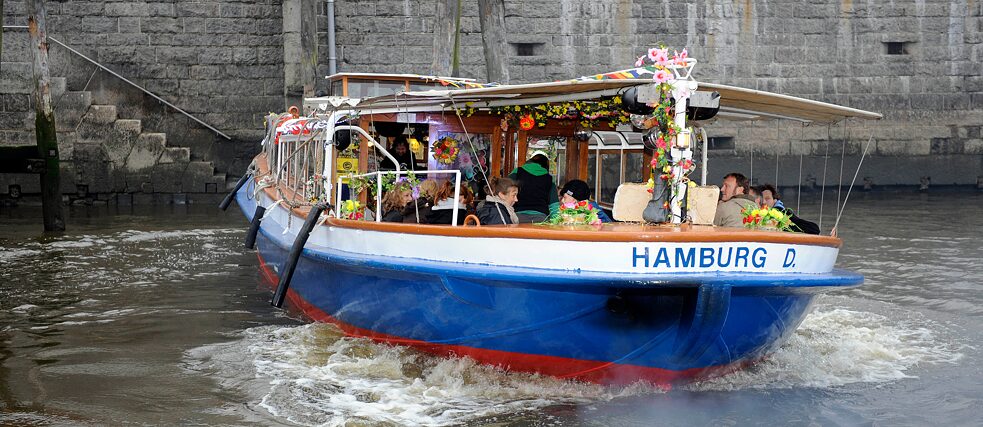 A weekday ride on a normal tourist barge is enjoyable, but on the weekend this ship turns into “Frau Hedis Tanzkaffee”, a nightclub that sails around the harbour and the illuminated Speicherstadt.
| Photo (detail): © picture-alliance/Isabel Schiffler/Jazzarchiv
A longstanding Hamburg tradition with a twist: a harbour tour on the Elbe River is a must for any tourist to the Hanseatic City. Sailors aboard the barge Hedi can look forward to a unique musical highlight on this floating nightclub with DJs and live bands. Depending on the event, the music on board ranges from Hamburg icon Andreas Dorau and rock ‘n’ roll institution Devil’s Day Off to DJ tours with the city’s best turntablists and international artists like Frank Turner. They provide the perfect musical backdrop to accompany a leisurely tour of Hamburg’s harbour. You don’t need to have good sea legs, but good stamina is definitely recommended.
A weekday ride on a normal tourist barge is enjoyable, but on the weekend this ship turns into “Frau Hedis Tanzkaffee”, a nightclub that sails around the harbour and the illuminated Speicherstadt.
| Photo (detail): © picture-alliance/Isabel Schiffler/Jazzarchiv
A longstanding Hamburg tradition with a twist: a harbour tour on the Elbe River is a must for any tourist to the Hanseatic City. Sailors aboard the barge Hedi can look forward to a unique musical highlight on this floating nightclub with DJs and live bands. Depending on the event, the music on board ranges from Hamburg icon Andreas Dorau and rock ‘n’ roll institution Devil’s Day Off to DJ tours with the city’s best turntablists and international artists like Frank Turner. They provide the perfect musical backdrop to accompany a leisurely tour of Hamburg’s harbour. You don’t need to have good sea legs, but good stamina is definitely recommended.
Comments
Comment